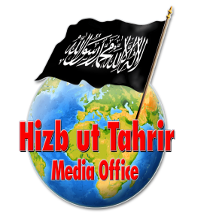Media Office
Wilayah Afghanistan
| H. 23 Rabi' II 1446 | No: Afg. 1446 / 10 |
| M. Saturday, 26 October 2024 |
Press Release
The Recent New York Times Article is Another Example of the U.S.’s Divisive Strategy Among Afghan Mujahideen
On October 24, The New York Times published articles based on an interview with Afghanistan’s current Interior Minister, including one titled, “Is Afghanistan’s Most-Wanted Militant Now Its Best Hope for Change?” These articles aim to create division and steer some Mujahideen toward U.S. interests.
The Media Office of Hizb ut Tahrir / Wilayah Afghanistan had previously warned of such policies by the U.S. and the West. In early 2023, Hizb held a campaign titled “The New and Dangerous Western Narrative Against the Mujahideen,” highlighting the U.S.’s deceptive strategy of dividing the Mujahideen into “extremist Taliban” and “moderate Taliban.” An 11-page document was also circulated in-person, detailing how Western media and think tanks pursue this divisive strategy.
The U.S. views the unity of the Afghan Mujahideen as an obstacle to its political, intelligence, and ideological influence. Therefore, it seeks to divide them into “extremist and bad Taliban” and “moderate and good Taliban,” engaging with the “moderate Taliban,” whom the U.S. considers “modest and good.” The New York Times article also uses motivational language to encourage greater engagement with certain figures, labeling them as “pragmatic” and “moderate.”
The terms used by Western politicians and media towards the authorities of the ruling regime have never been simple or meaningless – behind these terms lies a significant political agenda. Colonial powers have historically divided groups under various labels by creating false identities for each to solidify their dominance. The goal is to initially sow division in people’s minds and pave the way for ‘conflict and power struggle’ in the long run. This approach is a clear example of the well-known “divide and rule” policy.
During the Cold War, the U.S. used to employ this approach to differentiate between “moderate” and “radical” communist factions, seeking to engage with “moderate leaders” in communist countries to counter the Soviet influence. This strategy was also employed against the Mujahideen in Palestine, Syria, and Afghanistan during the Soviet era, dividing them into “moderate ones” and “extremist ones,” weakening and deviating their Islamic agenda by engaging with the moderate ones.
We understand that no Jihadi figure supports division, but it is essential to remain vigilant against Western agendas and avoid them. The West is engaging in flattery and aims to make the Mujahideen do the same. They target certain individuals, viewing them as bridges between Afghanistan and the West, considering these individuals the “best hope for change.” However, Hizb ut Tahrir / Wilayah Afghanistan, without endorsing and/or counting anyone as purified (Tazkia), assumes that some Mujahideen leaders, with their sincerity, hold potential for fundamental change—a change that would lead to the establishment of the Second Khilafah Rashidah (Rightly-Guided Caliphate) upon the method of the Prophethood, complete implementation of Islam, spreading Islam globally, and unifying the Ummah.
[فَلَا تُطِعِ الْمُكَذِّبِينَ وَدُّوا لَوْ تُدْهِنُ فَيُدْهِنُونَ وَلَا تُطِعْ كُلَّ حَلَّافٍ مَّهِينٍ هَمَّازٍ مَّشَّاءٍ بِنَمِيمٍ مَّنَّاعٍ لِّلْخَيْرِ مُعْتَدٍ أَثِيمٍ]
“So do not give in to the deniers. They wish you would compromise so they would yield ˹to you˺. And do not obey the despicable, vain oath-taker, slanderer, gossip-monger, withholder of good, transgressor, evildoer.” [Al-Qalam:8-12]
Media Office of Hizb ut Tahrir in Wilayah Afghanistan
| Hizb-ut Tahrir: Media office Wilayah Afghanistan |
Address & Website Tel: http://hizb-afghanistan.org/ |
E-Mail: info@hizb-afghanistan.org |





